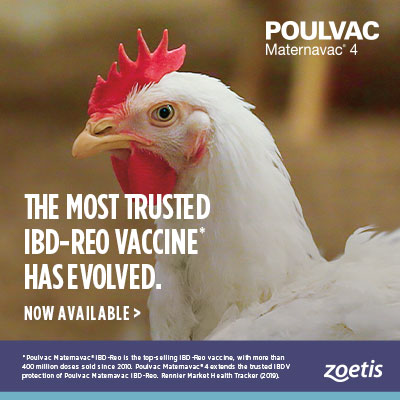Tuning up live-vaccine priming for infectious bursal disease and reovirus
An interview with Kalen Cookson, DVM, MAM, Director of Clinical Research, Zoetis
Q: Why is live priming of breeder pullets for infectious bursal disease virus (IBDV) and reovirus important?
KC: By initiating an immune response with live vaccines, pullets respond better and more uniformly to the killed IBDV and reovirus vaccines they’ll need later.
Q: When should live primers be administered?
KC: Situations differ, but I generally recommend giving the first live IBDV and reovirus vaccines between 2 and 3 weeks of age. Follow that with the second live primer for IBDV at 4 to 5 weeks and for reovirus at 5 to 6 weeks.1
Q: Aren’t most producers already providing live priming for breeder pullets?
KC: They are, and most understand it’s not a good idea to rely on inactivated IBDV and reovirus vaccines to provide a primary immune response. But there are opportunities to do a better job with live priming, particularly when vaccinating to protect pullets against variant reoviruses.
Q: How can live priming against reovirus be improved?
KC: It’s fine to use a mild reovirus vaccine for the first dose in younger birds. But unless that second dose is with a stronger vaccine, I’ve found pullets won’t be protected from variant reovirus challenges. In addition, you could end up with a subpopulation of chronic carriers.
Q: What happens if birds are chronic reovirus carriers?
KC: Naïve pullets that become infected with a field reovirus probably won’t develop clinical disease. When they go into production, however, they can shed the virus vertically into the egg. Then you’ve got broilers already positive for reovirus. That’s another important reason why proper live priming is so important. It protects pullets and progeny.
Q: How else can live priming for IBDV and reovirus be improved?
KC: Application method is really important. Uniformity is critical. These vaccines are usually given in water, so pay attention to good vaccine technique. For example, adding a vaccine conditioner to the water helps neutralize impurities that might harm vaccines.
Timing of water withdrawal is also important. Water not withheld long enough means birds won’t be thirsty enough to drink, but if water is withheld too long, the thirstiest and dominant birds will consume the lion’s share and some birds won’t get the vaccine at all. If it takes birds less than 1 hour to consume the vaccine, the water was probably withheld too long.
Q: What’s the consumption time for live IBDV and reovirus vaccines in water?
KC: About 90 minutes. That may seem like a long time, but IBDV and reovirus are hardy, and titers won’t drop like they will with respiratory vaccines. Allowing 90 minutes for consumption helps ensure uniform coverage.
Q: How long will broiler progeny be protected from IBDV and reovirus after live priming of breeder pullets?
KC: The more uniform and higher your IBDV and reovirus titers are in breeder pullets, the longer progeny will be protected. You want passive IBDV immunity for at least 14 and preferably 18 days. With reovirus, you want passive immunity until at least 10 days of age. Don’t be surprised if IBDV titers persist longer than reovirus titers.
Q: What else can be done to improve live IBDV and reovirus priming?
KC: Walk the house when vaccinating, especially along the side walls. If you see birds that aren’t going to water, get them moving to encourage them to drink.
Q: What about using a recombinant herpesvirus of turkey IBDV vaccine for priming?
KC: The recombinants do a good job protecting pullets but are no substitute for live priming. I say that based on experience with a large poultry company that used a recombinant without also using live priming, and the results were mixed. By the second or third growout, flocks in areas with a lower field challenge had IBDV titers at 10 weeks of age that were far lower compared to what they were with conventional priming. And the IBDV titer response after the inactivated vaccines was lower and less uniform.
Q: Do you have any tips for improving administration of the Zoetis inactivated IBDV and reovirus vaccine, Poulvac Maternavac®?
KC: Here again, proper administration is key. If the vaccination crew works too fast, they might vaccinate inaccurately or pull the needle out prematurely and end up giving a partial dose. Crews certainly need to work efficiently but not so fast that it jeopardizes proper administration.
1 Vaccination, Hyline. Accessed April 8, 2019.
IMPORTANT POULVAC MATERNAVAC SAFETY INFORMATION
- In case of accidental human injection seek immediate medical attention.
- Do not vaccinate within 42 days before slaughter.
TOOLBOX, Issue 13
Toolbox is a series of interviews with veterinarians and other technical specialists about their experiences managing antimicrobials, vaccines and other tools for poultry health. It is produced by the editors of Poultry Health Today on behalf of the US Poultry Business of Zoetis.
BIO-00181
Aug 2022
Posted on August 11, 2022















